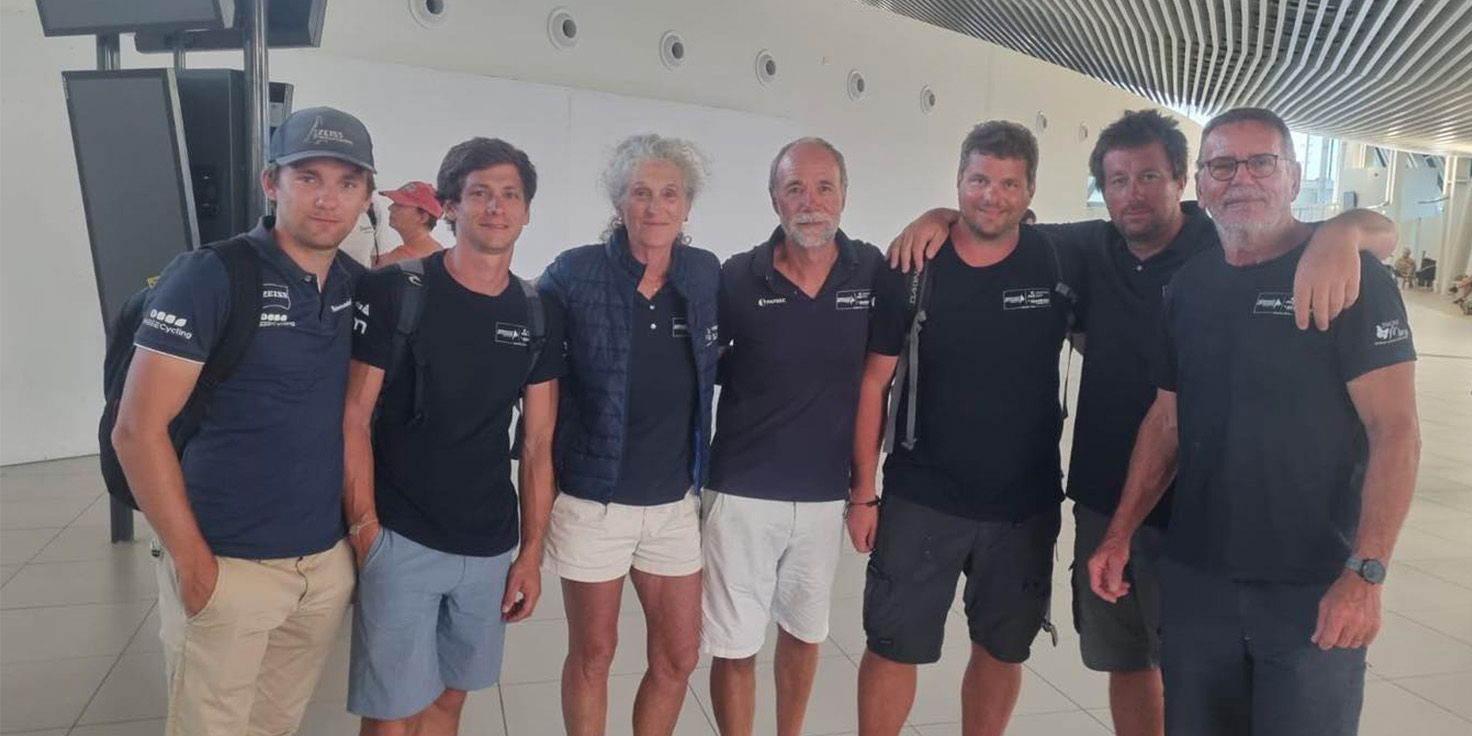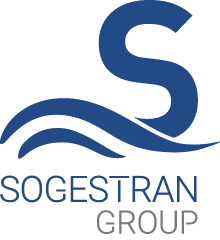New Twist for Class40 197
March 29th, 2024
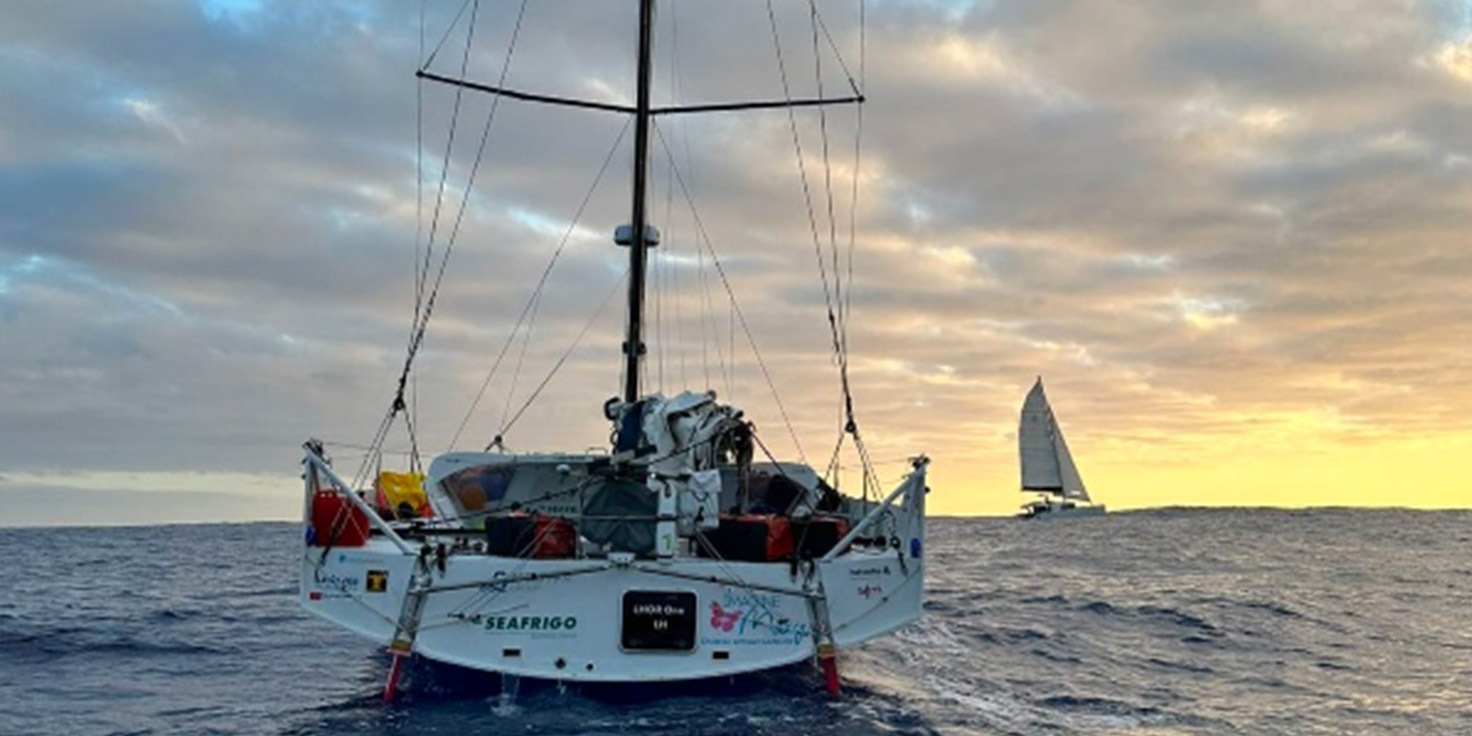
Lightning Strike in the Middle of the Atlantic then Rescue
After winning the RORC Caribbean 600 on February 22, 2024, the Class 40 197 Sogestran Seafrigo set sail for a return journey to France. On board were 2 young skippers: Pierrick Letouzé, 26 years old, a member of the Normandy Offshore Program, and Noa Geoffroy, 20 years old, a member of the Normandy Elite Team.
During the night of Sunday, March 4, to Monday, March 5, the Class40 fell victim to a lightning strike. This led to:
- a night of managing the emergency on the boat for the two young skippers, who showed courage, seriousness, and efficiency;
- followed by an evacuation of the crew onto a Panamanian merchant vessel, abandoning the Class40;
- and finally, the rescue of the Class40 by a dedicated team composed of Cédric Chateau, Guillaume Pirouelle, Timothé Polet, Romain Gayant, and 3 other seasoned sailors: Christophe Thébaud, MA Thébaud, and Philippe Corson.
As March comes to a close, while Pierrick Letouzé and Noa Geoffroy have returned to France, the Class40 197 awaits its fate from La Martinique. It is expected to return to France in the coming weeks to be repaired in Lorient. We are hopeful that it can set sail for North America in time to participate in the Transat Québec - Saint Malo (starting on June 30, 2024).
Tip & Shaft recounts the adventure: How the Class40 Sogestran Seafrigo was saved
The expert media outlet for competitive sailing interviewed the key individuals involved and published this account on March 15, 2024.
This article is available online on the Tip & Shaft website
During the night of Sunday, March 4, to Monday, March 5, the Class40 Sogestran Seafrigo, en route between the Caribbean and the Azores, was struck by lightning, causing electronics to fail and a hull breach. This forced the two sailors on board, Pierrick Letouzé and Noa Geoffroy, to evacuate onto a cargo ship, while the Normandy team coordinated a boat recovery operation. Tip & Shaft tells the story.
Sunday, February 25. Three days after winning the Caribbean 600, Sogestran Seafrigo, a Mach 40.5 launched in July 2023, left Pointe-à-Pitre with two men on board: Pierrick Letouzé, 26, a member of the Normandy Offshore Program, and Noa Geoffroy, 20. Their destination was the Azores, where Guillaume Pirouelle, this season’s skipper, was to take over for the solo journey to Lorient, thus validating his qualification for The Transat CIC. From Brittany, Guillaume Pirouelle tracked Class40 No. 197, equipped with a Yellow Brick beacon that emitted every hour.
Midway, they encountered a large cloud mass, which the duo aboard the boat had no choice but to cross from west to east. "I was in contact with them to help them out of the area when I noticed that some of my messages weren’t getting through, a first discouraging sign," explains Guillaume Pirouelle. The rest of the story is recounted by Pierrick Letouzé: "The lightning was getting closer and closer to the boat until we were struck by lightning (it was 11:52 PM). Noa was at the helm, I was inside, and everything went out all of a sudden. I then saw smoke everywhere, the fire alarm in the starboard tunnel went off, I panicked because we had a fuel cell, I was afraid the methanol would ignite, so I sprayed the extinguisher in the tunnel."
While on deck, Noa Geoffroy worked to roll the J2 and lower the mainsail in 25 knots of wind, Pierrick Letouzé realized that the lightning had passed through the mast cables to exit at the level of the hull camera through-hull fitting, which had exploded, causing a hole five centimeters in diameter, and thus a leak. "It quickly filled up because I had water almost up to my knees, my priority was to plug the hole, which I managed to do by pushing a foam plug with my foot."
The Americans Take Charge
With the sails lowered, Noa Geoffroy began bailing out water while Pierrick Letouzé retrieved the TPS suits, the grab bag (survival bag), and the life raft (which accidentally deployed in the cockpit, narrowly avoiding being punctured by the boom!) and activated two emergency beacons: the EPIRB and a PLB. In Le Havre, where he was also tracking the boat’s trajectory, Cédric Chateau quickly realized the severity of the situation: "At the moment the lightning struck, I received an email from the Yellow Brick, which must have undergone a reset. At 12:04 AM, I received a call from Cross Gris Nez (the maritime surveillance and rescue coordination center) informing me that the EPIRB had been activated. I explained the situation to them and provided the names and surnames of the two guys and a list of all safety equipment on board."
Forty minutes later, the American center in Norfolk called Cédric Chateau to explain that they were taking charge of the operation, including dispatching an aircraft to the area. At 3:15 AM, Cédric Chateau woke up Pauline Courtois, project manager, to change the Yellow Brick’s transmission frequency from one hour to every five minutes for more precise tracking of the boat. "We are also assisted in this setup by my brother Yann and Francis Le Goff (respectively race directors, among others, of the Solitaire du Figaro and the Transat Jacques Vabre)."
On board Sogestran Seafrigo, Pierrick Letouzé and Noa Geoffroy, unable to operate the grab bag’s Iridium, took turns to reinsert the foam plug, regularly ejected when the boat fell into a wave (about three meters high), and bailed out water. Pierrick Letouzé also assessed the damage: "All the electronics had melted, the fuses had blown, my computer’s USB hub was completely burnt." The first good news arrived at dawn: "I heard a buzzing noise, I thought it was due to my tinnitus following the lightning strike, but when I went out, I saw the Coast Guard plane, and we managed to speak to each other on VHF. They then went to search for cargo ships nearby and returned after an hour and a half to tell us that one of them was diverting."
To Evacuate or Not
In Le Havre, Cédric Chateau, unaware of the flyover, notified the sponsors, including Christophe Thébaud, former vice-president of Sogestran, in charge of overseeing the Class40 project, and the families. Relief came only at 12:25 PM: "We finally received a call from the Iridium (which had started working again), I won’t hide from you that it was a huge relief because we knew they were alive! Very quickly, we decided with them to evacuate the boat after securing it." Pierrick Letouzé confirms: "We took out the toolbox to cut a piece of monolithic material the size of the hole and make a sort of box; it took us quite some time to set it all up."
Meanwhile, Cédric Chateau, after exchanging ideas with figarist Alexis Loison, who had just completed a survival course in Lorient, reconsidered his position on evacuating the boat: "Everyone tells us that one of the biggest dangers is climbing onto the cargo wall. So I went back to them to tell them that they should stay on board if they believe it’s safer. I try to make them understand that this advice is solely based on their safety and not on wanting to recover the boat. It’s difficult for them because they are still in shock; they see the situation as catastrophic."
On board, Pierrick Letouzé is torn, realizing the danger of evacuation, but the crew of the Russian cargo ship Frio Ionan, arriving on site around 3 PM, gave little choice to the two sailors: "The captain first said he wanted to hoist the boat, we refused; after that, he turned into the wind to start the evacuation. It was tense because we didn’t have an engine since the starter had burnt out, he threw us a rope, which turned out to be a sort of pre-mooring line that they didn’t tension because they were waiting for us to grab the real one; so we were drifting back to the rear of the cargo ship, we saw the propeller coming out of the water! We were also afraid that the boat would crash against the cargo ship or that the mast would hit us. When we got the real mooring line, everyone pulled to move to the wooden ladder, and in a wave, we managed to grab it and both climb up at the same time, that’s when I was most scared. Especially since we narrowly missed the spreader bar while climbing... Once on the deck, we rested for five minutes to catch our breath, we saw the Class40 drifting away, it was really tough."
In Le Havre, the pressure increased because the crisis cell received no news until 5:57 PM: "Since they could only make one phone call from the boat, Pierrick called his partner, who immediately informed me," recounts Cédric Chateau. The two sailors then headed for Panama, where they arrived on Sunday, March 10, before flying to Paris the next day.
Towing Operation
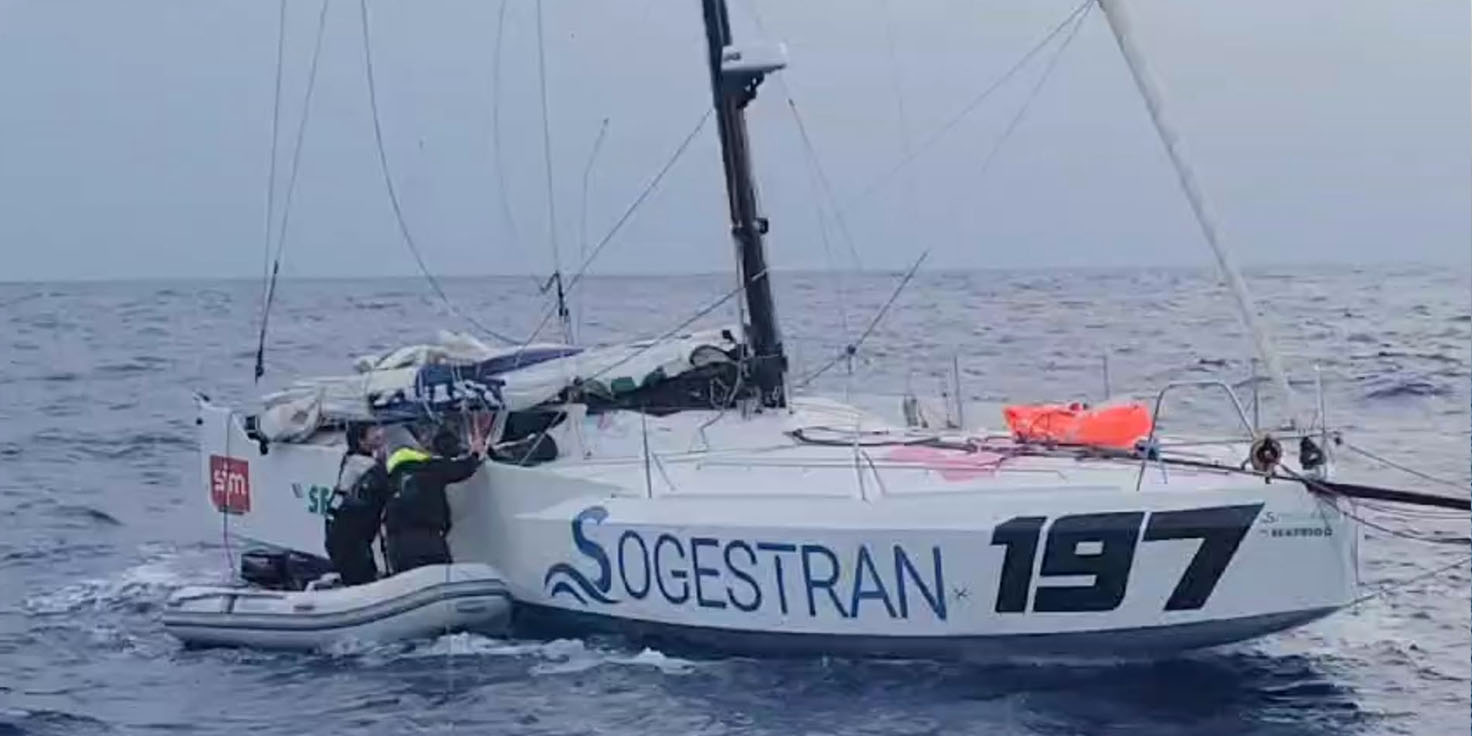 With the men safe and sound, the Sogestran Seafrigo team can now focus on the Class40 recovery operation. "We explored several options, including asking Adrien Hardy to do it (a figarist who has become a specialist in this type of mission), integrating him into the team, or, with his advice and that of others, setting up our own team. Which we did." The next step was to find a boat: Bermuda is closer than the Caribbean, but Guillaume Pirouelle points out that the risk of facing stronger depressions is higher.
With the men safe and sound, the Sogestran Seafrigo team can now focus on the Class40 recovery operation. "We explored several options, including asking Adrien Hardy to do it (a figarist who has become a specialist in this type of mission), integrating him into the team, or, with his advice and that of others, setting up our own team. Which we did." The next step was to find a boat: Bermuda is closer than the Caribbean, but Guillaume Pirouelle points out that the risk of facing stronger depressions is higher.
The choice fell on Martinique, where, fortunately, Matthieu Jones, owner of the company Alternative Sailing (sailboat rental) and owner of the Class40 of the same name (which he co-skippered with Estelle Greck on the last Transat Jacques Vabre), found a Lagoon 450F, while on site, the Alternative Sailing team, in liaison with Romain Gayant, Class40 preparer, found the necessary towing equipment and someone for provisioning. The Normandy team (Cédric Chateau, Guillaume Pirouelle, Christophe Thébaud, MA Thébaud, Romain Gayant, Timothé Polet, Philippe Corson) flew to Martinique on Wednesday, the 13th, and set sail from Le Marin the next day to reach the Class40, 950 miles away.
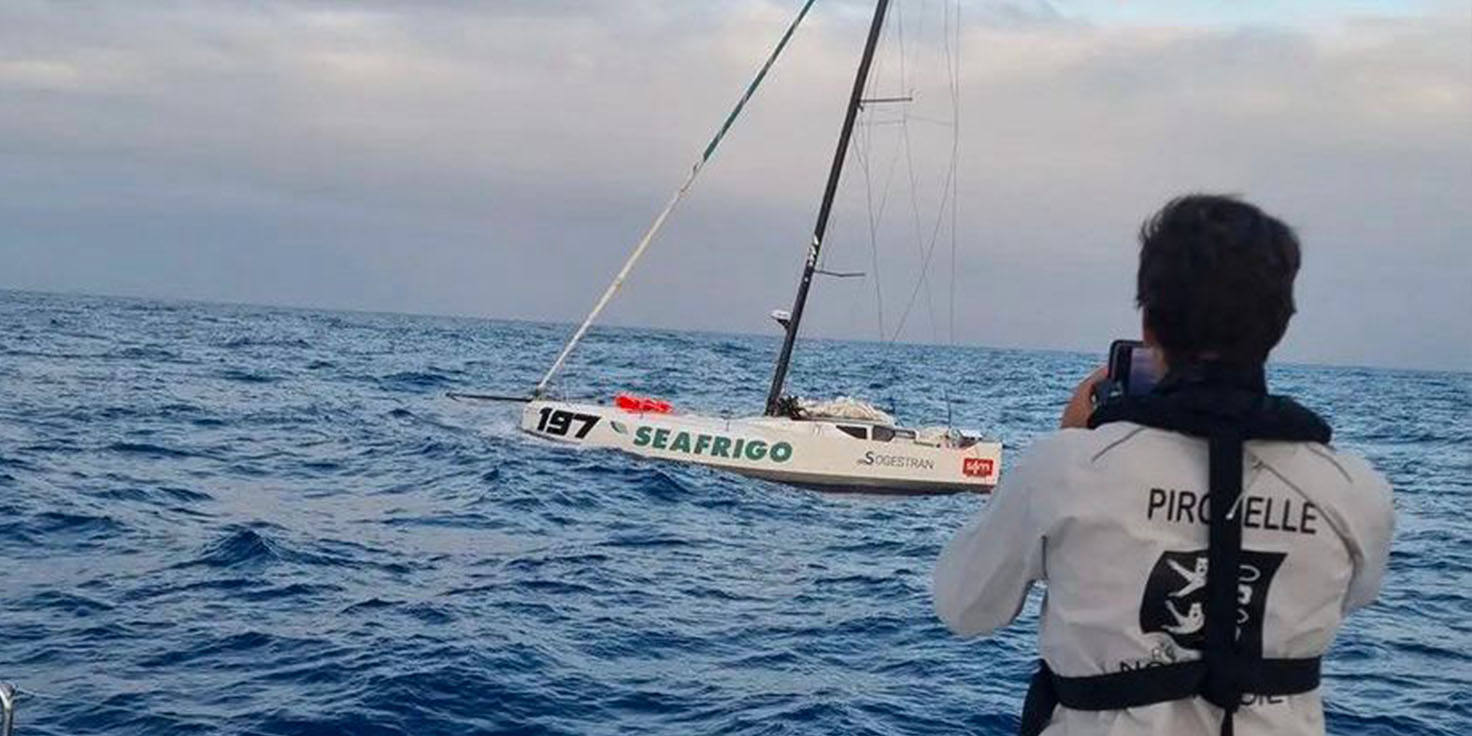 After five days at sea, they finally made visual contact with the boat, on which Guillaume Pirouelle and Romain Gayant boarded. "It was a bit chaotic," describes the former, "with a lot of water and diesel everywhere because some cans had leaked. It was not possible to spend the night on board, which was our first intention to make sure everything went well." After a few towing attempts, the "caravan" set off at nightfall towards Martinique, where it should arrive between Monday and Tuesday next week.
After five days at sea, they finally made visual contact with the boat, on which Guillaume Pirouelle and Romain Gayant boarded. "It was a bit chaotic," describes the former, "with a lot of water and diesel everywhere because some cans had leaked. It was not possible to spend the night on board, which was our first intention to make sure everything went well." After a few towing attempts, the "caravan" set off at nightfall towards Martinique, where it should arrive between Monday and Tuesday next week.
What’s Next?
"We are exploring all options, particularly because we have doubts about the integrity of the mast, a spreader broke during the transfer, and it may have been damaged by lightning," responds the skipper. Who knows he will have to skip the first part of the season. "It’s a big disappointment because we were about to move on to the development and performance improvement phase. We didn’t have much luck; I read that the probability of being struck by lightning was one in a million, but at the same time, we are very happy to have recovered the boat."
